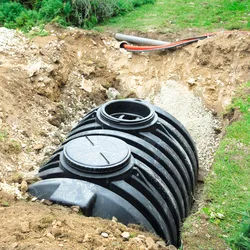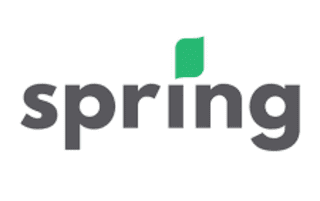Septic tanks are a necessity if your home isn’t connected to the local sewer plant. But the costs of buying and installing one can easily set you back several thousand dollars. Even making repairs can be pricey. Luckily, there are several septic tank financing options for keeping this essential piece of equipment in top shape.
How can I finance a septic tank?
Consider starting with the following options when looking for septic tank financing.
Home equity loans and HELOCs
Home equity loans and home equity lines of credit (HELOCs) are one of the most popular ways to fund home improvements, including repairing or replacing a septic tank. Also known as a second mortgage, a home equity loan involves borrowing against the amount you own in your home.
Backing your loan with your house can help you qualify for more competitive rates and terms than an unsecured personal loan, though you risk losing your home if you can’t pay it back.
Personal loans
Borrowers with decent credit might want to take out a personal loan to finance a septic tank. Personal loans typically range from $500 to $50,000 with APRs ranging from 6.99% to 46.96% and terms lasting from 3 – 60 months, sometimes longer. They’re provided as a lump sum that’s transferred directly into your account. Some lenders may ask you to specify why you’re applying for a personal loan, with home repairs as the main option.
Credit cards
You may be able to pay for your septic tank purchase, installation or repairs by swiping your credit card. This is a route worth considering especially if you can find a credit card with a 0% interest promotional period. In this case, your aim should be to try to pay off as much as possible before that promotional period is over to avoid the high interest rates that’ll kick in immediately after. If your credit card has incredibly steep interest rates, you’re better off shopping for another loan with better terms.
Personal line of credit
Homeowners may have an emergency personal line of credit set aside precisely for costly emergencies like replacing or repairing a septic tank. Similar to a credit card, a line of credit gives you a specified credit limit to use as you need. While personal loans give you a lump sum of funding you need to repay within a fixed amount of time, a line of credit stays open as long as you keep up with payments. Once you repay what’s withdrawn, you can re-access the money. You are only charged interest on what you use, too.
Seller-financed loan
If you’re shopping for a septic tank, you may find septic system sellers have their own financing options and payment plans available to consumers. They’re worth asking about when you get a quote because the seller may offer incentives, like extended warranties or no money down, to try to win your business. Keep in mind that you may need to pass a credit check to proceed with this option though.
While it may be enticing to go with seller financing to make the process a one-stop shop, do your homework and comparison shop before deciding on which financing option is right for you.
Hardware store financing
Many of Canada’s top hardware stores, such as Canadian Tire, The Home Depot, Home Hardware, Lowe’s and RONA, offer in-house septic financing programs that include loans and credit cards. You may even be able to participate in a rewards program and earn points towards free or discounted items when you make purchases such as a septic tank.
The table below summarizes some of the financing and rewards options available at major Canadian hardware retailers:
| Retailer | Loan financing | Credit card financing | Loyalty/Rewards program |
|---|---|---|---|
Canadian Tire |
| Triangle Mastercard
| Triangle rewards
|
The Home Depot | Project loan
| Consumer Credit Card
Commercial Credit Cards
| Pro Xtra program (only for registered businesses in Canada)
|
Home Hardware |
| Scotiabank Scene+ Visa
Scotia Home Hardware Pro Visa Business Card
|
|
RONA | PayPlan by RBC
Flexiti Buy Now Pay Later
Flexiti project loan plans
| N/A |
|
In addition to this, some companies have coupons on their website that offer discounts on services. You can typically use these in addition to financing to lower your cost even more.
Provincial tax benefits
Your province may offer a tax benefit, loan or grant program that can help offset the cost of a septic tank. While it’s unlikely that you’ll find opportunities designed to support the purchase and installation of septic tanks specifically, you may come across green initiatives or social supports that can be used for this purpose.
For instance, senior residents of Alberta may be able to get an equity-secured loan or grant through the Seniors Home Adaptation and Repair Program (SHARP) to fund home renovations so they can remain living independently as long as possible. Money can be used for walk-in tubs, stair lifts, roof and window replacement, electrical work and septic tank repairs, among many other things. Check with your provincial government to find out what opportunities may be available for you.
How much does a septic tank cost?
 Septic tank costs can vary widely depending on how big your house is, where you live and what type of system you want to install. You can expect to pay between $1,000 and $3,500 for a plastic or concrete tank or between $9,000 and $13,000 for an aerobic treatment unit, which uses oxygen to break down organic matter more quickly than conventional septic systems would.
Septic tank costs can vary widely depending on how big your house is, where you live and what type of system you want to install. You can expect to pay between $1,000 and $3,500 for a plastic or concrete tank or between $9,000 and $13,000 for an aerobic treatment unit, which uses oxygen to break down organic matter more quickly than conventional septic systems would.
However, there are other related costs as well such as excavation, installation and (if necessary) tree removal and city permits. Altogether, you could be looking at a whopping $15,000 – $30,000 when all is said and done. Installation costs include renting a backhoe to dig the hole for the tank as well as hiring someone to put in the tank and plumbing. You might also have to dig up and repave your driveway to install the pipes leading to the septic tank. Once it’s installed, you need to have it inspected and pumped every few years, which can set you back hundreds of dollars at minimum.
Representative example: Sandip gets a septic system
Sandip has just finished building her off-the-grid cabin in rural Ontario. She has just installed a solar panel system but now needs to get a septic tank system. She has opted for a model that costs $7,500.00 – which includes the system and installation costs.
Sandip has spent most of her savings building the cabin, so she doesn’t want to dip into her savings account any further. She decides to compare financing options from four lenders to find the most affordable loan option.
| Lender A | Lender B | Lender C | Lender D | |
|---|---|---|---|---|
| Amount borrowed | $7,500 | $7,500 | $7,500 | $7,500 |
| Interest rate | 13.99% | 0% | 7.99% | 12.99% |
| Loan term | 60 months | 24 months | 48 months | 36 months |
| Admin fee | $0 | $0 | $0 | $0 |
| Total interest | $2,968.38 | $0 | $1,286.96 | $1,596.07 |
| Total cost | $10,468.38 | $7,500 | $8,786.96 | $9,096.07 |
| Monthly payment | $174.47 | $312.50 | $183.06 | $252.67 |
Sandip decides to finance her septic tank with Lender B. She likes the fact that this lender offers 0% financing, providing the cheapest option of these four lenders.
Repairing a septic tank
There’s a chance that when you get your septic tank inspected, you’ll have to make repairs. This typically starts at $500 but can run as high as several thousand dollars. One of the most common repairs is replacing a broken pipe, which can cost around $2,000 — and might involve digging up your driveway again.
But if your septic tank has started to contaminate the area around it, you might have to move it to another location, which can set you back at least $10,000. In fact, it can sometimes end up being more expensive to replace an old tank than to install a new tank on a new property.
Low interest personal loans that offer $10,000
Seven tips for protecting your septic tank
The better you care for your septic tank, the less often you’ll need to make expensive repairs. Here are four ways to keep it in top shape:
- Use a high-efficiency shower head. Your septic tank can only handle so much water at once before it starts to back up. A high-efficiency shower head can help prevent that.
- Have multiple laundry days. Dividing your laundry into several smaller loads can also ensure you aren’t overloading your tank with water.
- Avoid your garbage disposal. Using a garbage disposal means you’ll have a lot more solid waste going into your tank, which leads to more frequent pumps.
- Watch what you flush. Anything that isn’t biodegradable can clog up your drain. This includes things you might not expect like dental floss, coffee grounds and any kind of oil or grease.
- Don’t dump toxic chemicals.Your septic tank is full of organisms that help digest your waste. Keep them alive and well by avoiding chemical drain openers, grease and paints down any drains.
- Inspect often. Experts recommend having your tank pumped and inspected by a professional at least once every three years to catch any potential problems.
- Maintain your drainfield. This means don’t park your car, plant trees or have any other kinds of drains run off into the area around your septic tank.
Bottom line
There are lots of financing options for installing or repairing a septic tank. Depending on where you’re buying your tank, you may be able to get financing through in-store credit. You can also look into provincial grants or initiatives that can help offset the cost of buying and installing a new tank. A personal loan might be a better solution if you can’t get in-store financing and don’t have enough to pay for the costs upfront on your own.
Read our personal loans guide to learn more about how they work and compare providers.
Frequently asked questions
More guides on Finder
-
Options and costs for financing landscaping projects
Compare loan options to finance your landscaping project.
-
6 ways to get electronics financing in Canada
Compare six ways to finance electronics in Canada, including financing for bad credit.
-
Electric bike financing in Canada
Searching for affordable e-bike financing in Canada? Check out these six options.
-
5 ways to get MacBook financing in Canada
Get the MacBook you want at a price you can afford.
-
How to finance a mattress or bed in Canada
Read our guide to the six ways to finance a mattress or bed.
-
How to finance a TV in Canada
Read our guide to the six ways to finance a TV in Canada, including options for bad credit.
-
5 ways to get appliance financing in Canada
If you’re not looking to pay for your next household appliance in cash, here are 5 ways to get appliance financing in Canada.
-
iPhone financing in Canada
Find out your options for iPhone financing in Canada.
-
How to finance a hot tub
Soothe those aching muscles or just hang out with loved ones without having to shell out thousands up front.



